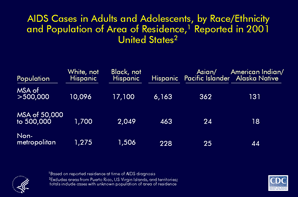|
|
|
|
|
|
||
|
Divisions of HIV/AIDS Prevention |
|||||||
| Slide Sets | Home | Index | Search | Site Map | Subscribe | Contact Us |
HIV/AIDS Surveillance in Urban and Nonurban Areas
L206 slide series
(through 2001)
Download complete set (12 slides) in PDF format (Adobe Acrobat v5.0 or higher) - (562 KB)
Download complete set (12 slides) in PPT format (PowerPoint 2002 required) - (443 KB)
NOTE: These
slides are in the public domain and may be used without special permission.
See "Instructions for Downloading and
Using HIV/AIDS surveillance slides".
Adobe Acrobat (TM) Reader v5.0 or higher needs to be installed on your computer
in order to be able to read the slides in Adobe PDF (Portable Document Format).
Download the Adobe Acrobat (TM) Reader
 |
 |
| Slide #1 HIV/AIDS in Urban-Nonurban Areas |
Slide #2 AIDS Cases in Adults and Adolescents, by Population of Area of Residence, Reported in 2001 and Cumulative, United States |
| Zoom/Download Slide #1 | Zoom/Download Slide #2 |
 |
 |
| Slide #3 Percentage Distribution of AIDS Cases in Adults and Adolescents, by Population of Area of Residence, 1994-2001, United States |
Slide #4 Regions of the United States |
| Zoom/Download Slide #3 | Zoom/Download Slide #4 |
 |
 |
| Slide #5 AIDS Cases in Adults and Adolescents, by Region and Population of Area of Residence, Reported in 2001, United States |
Slide #6 Percentage Distribution of AIDS Cases in Adults and Adolescents, by Region and Population of Area of Residence, Reported in 2001, United States |
| Zoom/Download Slide #5 | Zoom/Download Slide #6 |
 |
 |
| Slide #7 AIDS Cases in Adults and Adolescents, by Race/Ethnicity and Population of Area of Residence, Reported in 2001, United States |
Slide #8 Percentage Distribution of AIDS Cases in Male Adults and Adolescents, by Risk Exposure and Population of Area of Residence, Diagnosed through 2001, United States |
| Zoom/Download Slide #7 | Zoom/Download Slide #8 |
 |
 |
| Slide #9 Percentage Distribution of AIDS Cases in Female Adults and Adolescents, by Risk Exposure and Population of Area of Residence, Diagnosed through 2001, United States |
Slide #10 AIDS Cases in Adults and Adolescents, by Age at Diagnosis and Population of Area of Residence, Reported in 2001, United States |
| Zoom/Download Slide #9 | Zoom/Download Slide #10 |
 |
 |
| Slide #11 AIDS Cases in Adults and Adolescents in Nonmetropolitan Areas, Reported in 2001 |
Slide #12 Cases of HIV Infection in Adults and Adolescents in Nonmetropolitan Areas, Reported in 2001 |
| Zoom/Download Slide #11 | Zoom/Download Slide #12 |
